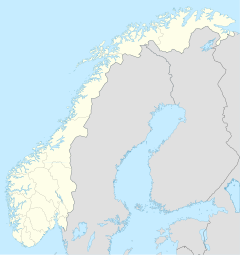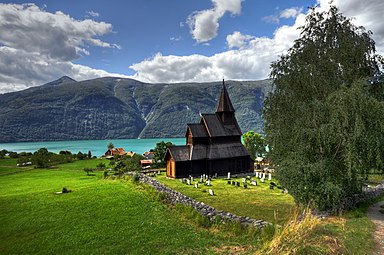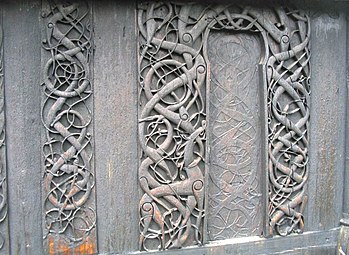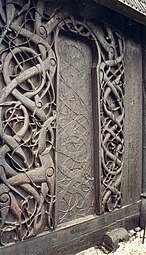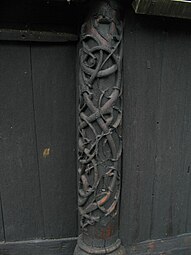
Romanesque architecture is an architectural style of medieval Europe that was predominant in the 11th and 12th centuries. The style eventually developed into the Gothic style with the shape of the arches providing a simple distinction: the Romanesque is characterized by semicircular arches, while the Gothic is marked by the pointed arches. The Romanesque emerged nearly simultaneously in multiple countries ; its examples can be found across the continent, making it the first pan-European architectural style since Imperial Roman architecture. Similarly to Gothic, the name of the style was transferred onto the contemporary Romanesque art.
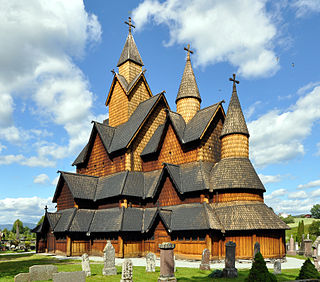
A stave church is a medieval wooden Christian church building once common in north-western Europe. The name derives from the building's structure of post and lintel construction, a type of timber framing where the load-bearing ore-pine posts are called stafr in Old Norse. Two related church building types also named for their structural elements, the post church and palisade church, are often called 'stave churches'.

Borgund Stave Church is a former parish church initially of the Catholic Church and later the Church of Norway in Lærdal Municipality in Vestland county, Norway. It was built around the year 1200 as the village church of Borgund, and belonged to Lærdal parish until 1868, when its religious functions were transferred to a "new" Borgund Church, which was built nearby. The old church was restored, conserved and turned into a museum. It is funded and run by the Society for the Preservation of Ancient Norwegian Monuments, and is classified as a triple-nave stave church of the Sogn-type. Its grounds contain Norway's sole surviving stave-built free-standing bell tower.
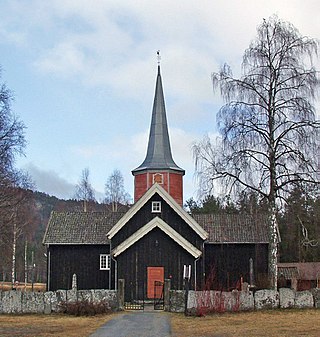
Flesberg Stave Church is a stave church located at Flesberg in Buskerud county, Norway.

Hopperstad Stave Church is a historic parish church of the Church of Norway in the village of Vikøyri in Vik Municipality in Vestland county. It was historically the church for the Hopperstad parish in the Diocese of Bjørgvin. The church is currently owned by the Society for the Preservation of Ancient Norwegian Monuments. The brown, wooden stave church was built during the 12th century. The church seats about 30 people.

Eidsborg Stave Church is a parish church of the Church of Norway in Tokke Municipality in Telemark county, Norway. It is located in the village of Eidsborg. It is one of the churches for the Eidsborg, Mo, og Skafså parish which is part of the Øvre Telemark prosti (deanery) in the Diocese of Agder og Telemark. The brown, wooden stave church was built in a long church design around the year 1250 using plans drawn up by an unknown architect. The church seats about 70 people.

Nore Stave Church is a stave church located at Nore in Nore og Uvdal kommune in Buskerud county, Norway.

Lomen Stave Church is a stave church of the Church of Norway in Vestre Slidre Municipality in Innlandet county, Norway. It is located in the village of Lomen. It was formerly the church for the Lomen parish which is part of the Valdres prosti (deanery) in the Diocese of Hamar. The brown, wooden church was built in a long church design around the year 1192 using plans drawn up by an unknown architect. The church seats about 150 people.

Gol Stave Church is a 12th century stave church originally from Gol in the traditional region of Hallingdal in Buskerud county, Norway. The reconstructed church is now a museum and is now located in the Norwegian Museum of Cultural History at Bygdøy in Oslo, Norway.
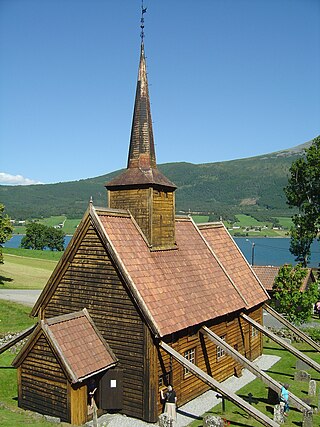
Rødven Stave Church is a former parish church of the Church of Norway in Rauma Municipality in Møre og Romsdal county, Norway. The stave church is located in the village of Rødven. It was a church in the Eid og Holm parish which is part of the Indre Romsdal prosti (deanery) in the Diocese of Møre. The brown, wooden church was built in a long church design during the 12th century by an unknown architect. The church seats about 100 people.

The Church of St. Trophime (Trophimus) is a Roman Catholic church and former cathedral located in the city of Arles, in the Bouches-du-Rhône Department of southern France. It was built between the 12th century and the 15th century, and is in the Romanesque architectural tradition. The sculptures over the church's portal, particularly the Last Judgement, and the columns in the adjacent cloister, are considered some of the finest examples of Romanesque sculpture.

The Church of Saint-Germain-des-Prés is a Roman Catholic parish church located in the Saint-Germain-des-Prés quarter of Paris. It was originally the church of a Benedictine abbey founded in 558 by Childebert I, the son of Clovis, King of the Franks. It was destroyed by the Vikings, rebuilt, and renamed in the 8th century for Saint Germain, a 6th century bishop. It was rebuilt with elements in the new Gothic style in the 11th century, and was given the first flying buttresses in the 12th century. It is considered the oldest existing church in Paris.

Saint-Pierre de Montmartre is the second oldest surviving church in Paris, after the Abbey of Saint-Germain-des-Pres. It is one of the two main churches on Montmartre, the other being the more famous 19th-century Sacré-Cœur Basilica, just above it. Saint-Pierre de Montmartre, begun in 1133, was the church of the prestigious Montmartre Abbey, destroyed in the French Revolution.
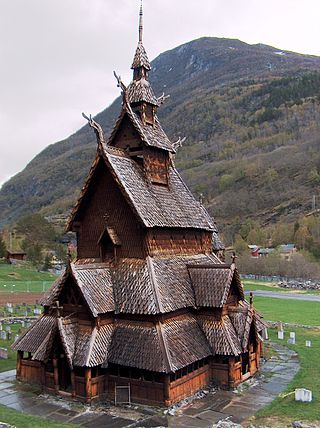
The major aspects of Medieval Scandinavian architecture are boathouses, religious buildings, and general buildings.

Mære Church is a parish church of the Church of Norway in Steinkjer municipality in Trøndelag county, Norway. It is located in the village of Mære. It is the church for the Mære parish which is part of the Stiklestad prosti (deanery) in the Diocese of Nidaros of the Church of Norway. The white, plastered stone church was built in a long church style during the 12th century using plans drawn up by an unknown architect. The church seats about 310 people.

Stubbekøbing Church is located in Stubbekøbing some 18 km (11 mi) northeast of Nørre Alslev on the Danish island of Falster. The basilical nave was built of limestone in the Late Romanesque period. Choir and tower are of brick, the choir built in Early Gothic style, tower and the northern chapels in the 15th century in Late Gothic style. In addition to its Renaissance altarpiece and pulpit, it has a variety of old frescos and wall decorations (1300–1500).
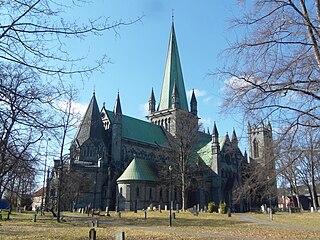
Church building in Norway began when Christianity was established there around the year 1000. The first buildings may have been post churches erected in the 10th or 11th century, but the evidence is inconclusive. For instance under Urnes Stave Church and Lom Stave Church there are traces of older post churches. Post churches were later replaced by the more durable stave churches. About 1,300 churches were built during the 12th and 13th centuries in what was Norway's first building boom. A total of about 3,000 churches have been built in Norway, although nearly half of them have perished. From 1620 systematic records and accounts were kept although sources prior to 1620 are fragmented. Evidence about early and medieval churches is partly archaeological. The "long church" is the most common type of church in Norway. There are about 1620 buildings recognized as churches affiliated with the Church of Norway. In addition, there are a number of gospel halls belonging to the lay movement affiliated with the Church of Norway as well as churches belonging to other Christian bodies. Until the 20th century, most churches were built from wood. 220 buildings are protected by law, and an additional 765 are listed as valuable cultural heritage.

The Romanesque style of architecture was introduced in Portugal between the end of the 11th and the beginning of the 12th century. In general, Portuguese cathedrals have a heavy, fortress-like appearance, with crenellations and few decorative elements apart from portals and windows. Portuguese Romanesque cathedrals were later extensively modified, among others the Old Cathedral of Coimbra, although it only had some minor changes.

Romanesque architecture appeared in France at the end of the 10th century, with the development of feudal society and the rise and spread of monastic orders, particularly the Benedictines, which built many important abbeys and monasteries in the style. It continued to dominate religious architecture until the appearance of French Gothic architecture in the Île-de-France between about 1140 and 1150.


